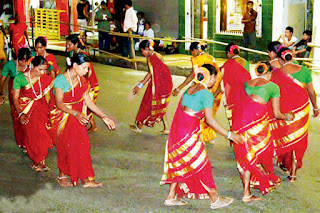Golf dance also called ''ribbon dance'' is one of the popular folk dances of Goa. It is performed during the Shigmo festival in Phalgun month. Goan peasants mainly practice this dance after the harvest as manifestation of their enjoyment. This dance has an affinity with tribal dance form of Gujarat state. The dance is a major attraction during the festive season and it attracts audiences from various part f a country. Cancona was one the last territories which were taken over by the Portuguese in Goa. Owing to this reason, the people here are much more rooted to their past tradition.
Performance of Golf dance
Generally , this folk dance is performed in a group. the dance can be performed by a group of males or females. Each dancer hold a colorful cord which hangs at the center point of the 'mand', which is place of dance performance. The dancers start dancing intricately forming a beautiful, colorful intricate braid at the end of the first movements. The music begins once again and the dancers reverse the pattern of dancing in such a movement, the braids gets unrevealed and all the cords are loose and single once again.
There are four different braids of Goff dance. The songs that are sung during the dance performance are mostly devoted to Lord Krishna.
Musical Instrument of Golf dance Ghumat, Samael and Surta Shansi or melodic musical instrument accompany the dance performance.
Costume of Golf dance
The costume of this folk dance is varied however all the attires are traditional. Some male groups prefer to wear kurta - pajama and some kurta dhoti. One the other hand, some females dance group clad themselves in ghagra -choli while some sari.




